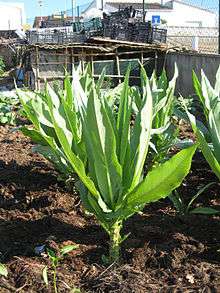Celtuce
| Celtuce | |
|---|---|
 Celtuce stems & heads | |
| Species | Lactuca sativa var. augustana |
| Cultivar | 'Celtuce' |
| Origin | Mediterranean region |
Celtuce (Lactuca sativa var. augustana,[1][2][3] angustata, or asparagina), also called stem lettuce,[4] celery lettuce, asparagus lettuce,[5] or Chinese lettuce, IPA (UK,US) /ˈsɛlt.əs/. It is a cultivar of lettuce grown primarily for its thick stem,[5] or its leaves. It is used as a vegetable, and is especially popular in Taiwan,[2] and China, where it is called wosun,[5] (Chinese: 莴笋; pinyin: wōsǔn),[6] or woju (Chinese: 莴苣; pinyin: wōjù) (although the latter name may also be used to mean lettuce in general). In the south of China, it is also called (Chinese: 油麦菜; pinyin: yóu mài cài) or ‘ou sen’.[7]
The pale green leaves,[5] which are tender,[2] and white stems,[4] can be eaten raw (in salads) or cooked. It can be pickled, grilled, roasted, or stir-fried.[5][4] It is mild but nutty, with a slight smoky aftertaste.[5][6] It is high in vitamins.[4]
It is thought to have come from the Mediterranean region and then brought to China during Tang Dynasty,[6] about A.D. 600-900.[7]
It can be grown from seed, sown from April and May. Into a set bed or a temporary nursery bed and then transplanted to the growing site. They should be spread 30cm apart each way. The young (edible) leaves are ready about 4-5 weeks after planting and the edible stems are ready when about 30cm tall, they are usually harvested between July and September.[4]
The plant can suffer from aphid attack.[7]

| Nutritional value per 100 g (3.5 oz) | |
|---|---|
| Energy | 75 kJ (18 kcal) |
|
3.65 g | |
| Dietary fiber | 1.7 g |
|
0.3 g | |
|
0.85 g | |
| Vitamins | |
| Vitamin A equiv. |
(22%) 175 μg |
| Thiamine (B1) |
(5%) 0.055 mg |
| Riboflavin (B2) |
(6%) 0.07 mg |
| Niacin (B3) |
(4%) 0.55 mg |
| Pantothenic acid (B5) |
(4%) 0.183 mg |
| Vitamin B6 |
(4%) 0.05 mg |
| Folate (B9) |
(12%) 46 μg |
| Vitamin C |
(23%) 19.5 mg |
| Minerals | |
| Calcium |
(4%) 39 mg |
| Iron |
(4%) 0.55 mg |
| Magnesium |
(8%) 28 mg |
| Manganese |
(33%) 0.688 mg |
| Phosphorus |
(6%) 39 mg |
| Potassium |
(7%) 330 mg |
| Sodium |
(1%) 11 mg |
| Zinc |
(3%) 0.27 mg |
|
| |
| |
|
Percentages are roughly approximated using US recommendations for adults. Source: USDA Nutrient Database | |
The stem is usually harvested at a length of around 15–20 cm and a diameter of around 3–4 cm. It is crisp, moist, and mildly flavored, and typically prepared by slicing and then stir frying with more strongly flavored ingredients.

.jpg)
See also
References
- ↑ Stanley J. Kays Cultivated Vegetables of the World: A Multilingual Onomasticon, p. 658, at Google Books
- 1 2 3 Masatoshi Yamaguchi World Vegetables: Principles, Production and Nutritive Values, p. 208, at Google Books
- ↑ Caroline Foley How to Plant Your Allotment, p. 51, at Google Books
- 1 2 3 4 5 "Celtuce or Stem Lettuce". kingsseeds.com. Retrieved 28 January 2017.
- 1 2 3 4 5 6 Nosowitz, Dan (29 April 2016). "Meet The Vegetable: Celtuce, a Mutant and Delicious Lettuce ..on". modernfarmer.com. Retrieved 28 January 2017.
- 1 2 3 "Celtuce ribbon salad". soyricefire.com. 21 April 2013. Retrieved 28 January 2017.
- 1 2 3 "Celtuce, 'Wo Sun'". seedaholic.com. Retrieved 28 January 2017.